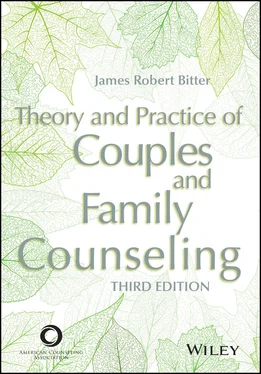James Robert Bitter - Theory and Practice of Couples and Family Counseling
Здесь есть возможность читать онлайн «James Robert Bitter - Theory and Practice of Couples and Family Counseling» — ознакомительный отрывок электронной книги совершенно бесплатно, а после прочтения отрывка купить полную версию. В некоторых случаях можно слушать аудио, скачать через торрент в формате fb2 и присутствует краткое содержание. Жанр: unrecognised, на английском языке. Описание произведения, (предисловие) а так же отзывы посетителей доступны на портале библиотеки ЛибКат.
- Название:Theory and Practice of Couples and Family Counseling
- Автор:
- Жанр:
- Год:неизвестен
- ISBN:нет данных
- Рейтинг книги:5 / 5. Голосов: 1
-
Избранное:Добавить в избранное
- Отзывы:
-
Ваша оценка:
- 100
- 1
- 2
- 3
- 4
- 5
Theory and Practice of Couples and Family Counseling: краткое содержание, описание и аннотация
Предлагаем к чтению аннотацию, описание, краткое содержание или предисловие (зависит от того, что написал сам автор книги «Theory and Practice of Couples and Family Counseling»). Если вы не нашли необходимую информацию о книге — напишите в комментариях, мы постараемся отыскать её.
Theory and Practice of Couples and Family Counseling — читать онлайн ознакомительный отрывок
Ниже представлен текст книги, разбитый по страницам. Система сохранения места последней прочитанной страницы, позволяет с удобством читать онлайн бесплатно книгу «Theory and Practice of Couples and Family Counseling», без необходимости каждый раз заново искать на чём Вы остановились. Поставьте закладку, и сможете в любой момент перейти на страницу, на которой закончили чтение.
Интервал:
Закладка:
7 Step 7: Enumerate possible consequences of the various options. For the first option above, the child would probably receive the medical care indicated. The parents might be placed on probation and mandated to a parenting program, after which they might regain custody of their child. The parents themselves might be bitter and even more distrustful of both the government and family counseling or therapy. There is very little chance that they will ever consider therapeutic interventions of any kind again. Imagine this case for a moment. Given today’s world, the media will already have attended to this story, and thousands will now know your actions. These thousands will now take in this event and connect it to their attitudes toward the helping professions. Should an awareness of the public nature of your decision factor into your decision-making process?The second option above will invariably lead the parents to respect your ability to honor the family’s right to make decisions regarding their child. It is still uncertain as to whether your actions will lead to further involvement with the authorities—either for the parents or for you. It is quite likely that the child’s condition will worsen and may lead to death. How will you feel about your decision then? This action too will catch the attention of the public. How might the public view family practitioners if you pursue this option?
8 Step 8: Choose what appears to be the best course of action. Hopefully you see the two options described here as only two of many more options that might be available. The very application of this model based solely on principle ethics demonstrates how often no-win possibilities occur. Let us see if virtue ethics adds anything to our considerations.
A Virtue Ethics Model
Most professional codes are based on principle ethics. Except for a few aspirational statements in some codes, there is very little in the documents themselves that pertains to virtue ethics. As we have noted before, virtue ethics requires the professional to look inward and make space for a self-reflective process. Attending to oneself in ethical decision-making opens the door for the emotional experiences of empathy and compassion. Cohen and Cohen (1999) viewed the role of emotion in decision-making as a legitimate component of a “morally good motive” and noted that “moral action is no mere affair of rules but is instead infused with emotion, human relatedness, and sensitivity to the nuances of individual context” (p. 24). A decision-making process based on virtue ethics would include many of the following questions:
What is my gut telling me about the family’s situation?
If I were in the parents’ shoes, what might I feel or want to do? How would I answer the same question for the child, extended family members, family friends, or the community?
How important is my own spiritual or religious value system to me, and how hard might I fight to have it respected? Does this tell me anything about what the family is experiencing? How open am I to accepting that my view of the right choice might be different from the view of the right choice held by various family members?
How open am I to accepting that my view might be different from the state’s view? Am I willing to be courageous and stand up for my view or for the clients’ views if they are different from what the law requires?
Do I agree with what the codes suggest I do in this situation? Do the codes help me to be the preferred family practitioner I want to be?
Which possible courses of action best fit my preferred view of myself as a family practitioner? Which personal and professional values are activated in me as I face this dilemma: caring, compassion, judgment, courage, humility, connectedness? Other values or virtues?
Which choice am I willing to live with? How ready am I to make a choice and live with the uncertainty of its outcome?
When infusing your ethical decision-making with virtue ethics, you bring yourself deeply into the ethical decision-making process. How central to the decision-making process are you willing to place yourself as a family practitioner? Is it possible to be too central? What would that look like for you?
A Participatory Ethics Model
What might a model of ethical decision-making based on participatory ethics look like? The specific process we propose here is based on the model of feminist ethical decision-making constructed by Rave and Larsen (1995) and the model for the vulnerable therapist described by Coale (1998). Participatory ethics retains much of the structure of a rational-evaluative process and still requires the self-reflection of a feeling-intuitive process. But instead of leaving ethical decisions completely in the hands of the family practitioner, participatory ethics focuses on the relational, coconstructed knowledge that comes from active involvement of clients in the decision-making process. The model may be applied as follows:
1 Recognizing a problem. Problem recognition comes from a combination of perspectives. The family practitioner’s personal and professional knowledge, competence, and gut feelings are combined with the clients’ local knowledge and gut feelings in an effort to understand and clarify the ethical dilemma. The family practitioner’s task is to open space within the counseling or therapy sessions for the clients to inform the ethical process. They open space by actively encouraging input, feedback, and the sharing of client perspectives on the counseling process.
2 Defining the problem. Once the counselor and the clients come to an understanding of the ethical dilemma that is present, each party contributes to a conversation about how to define and frame the problem. All of the questions posed by the virtue ethics model related to stakeholders and feelings are relevant here. What extends the virtue ethics model is the inclusion of the clients in defining the problem as well as understanding the cultural values that the family practitioner brings to the process. From a postmodern perspective, the cultural selves of family practitioners are not simply acknowledged and managed but are embraced and brought into conversations with the clients. In this way, the emphasis is on situating the counselor’s selves as cultural beings within the decision-making process, highlighting, not hiding, such influences. The family practitioner trusts the family to handle the very human, ethical struggle in which the practitioner and all other parties are engaged.
3 Developing solutions. This step of the participatory ethics model is very similar to Steps 5 and 6 of the virtue ethics model. Again, the defining element of the participatory model is valuing clients’ conceptualizations of solutions and their reaction to each possibility. Consultation is integral to the process of developing solutions and may involve inviting still other voices into collaborative conversations with clients.Even though we are presenting the participatory ethics model in linear steps, in this model, like most approaches to family systems, the steps are recursive—with each step influencing and being influenced by the others. Furthermore, it is not uncommon for each additional step to require adjustments and reconsiderations in earlier steps. All of this is especially true when consultation is being integrated into the process. Engaging in consultation may require circling back to previous conversations, and consultation may be integrated throughout the rest of the process. In participatory ethics, no single step can be a one-time occurrence in the process of ethical decision-making.
4 Choosing a solution. Just as the virtue ethics model values self-reflection at both the rational and emotional levels, participatory ethics values conversations with clients about their processes and reactions, rationally and emotionally, to possible solutions. Respect for self-agency is central to the dialogue, and the goal is to select a solution that all parties, including the family practitioner, can support.
Читать дальшеИнтервал:
Закладка:
Похожие книги на «Theory and Practice of Couples and Family Counseling»
Представляем Вашему вниманию похожие книги на «Theory and Practice of Couples and Family Counseling» списком для выбора. Мы отобрали схожую по названию и смыслу литературу в надежде предоставить читателям больше вариантов отыскать новые, интересные, ещё непрочитанные произведения.
Обсуждение, отзывы о книге «Theory and Practice of Couples and Family Counseling» и просто собственные мнения читателей. Оставьте ваши комментарии, напишите, что Вы думаете о произведении, его смысле или главных героях. Укажите что конкретно понравилось, а что нет, и почему Вы так считаете.












